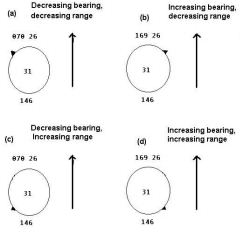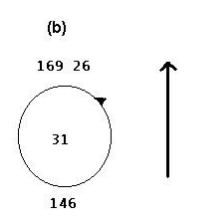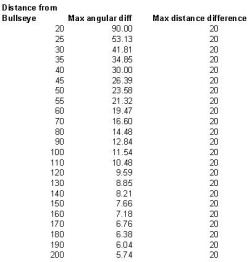|
A Practical Guide to Using Bullseye Radio Calls
by Rick "Drummer" Centeno |
||||
|
Now the rule for turning towards a position with a lower bearing is simple: keep the bullseye left of you. If you want to keep your distance to bullseye constant, put the bullseye at your 9 o' clock (or equivalently put the tick-mark at the 9 o' clock of the circle). To turn towards a position with a larger bearing, keep the bullseye on your right! Decreasing the range from bullseye is achieved by flying towards it, right? So put the little tickmark on the top half of the circle. To increase the distance, ensure that the tickmark is on the bottom half of the circle. Easy isn't it? Anyway, to summarize these simple rules look at the following picture which shows the effects on bearing and distance while flying in a certain direction based on your relative position from bullseye.
 Figure 1 As a practical example, say your position is as shown in Figure 1(a) bearing 146, distance 31 nm, and that you're flying North. Suddenly, you receive a call from AWACS that the nearest threat is at bullseye 165, 20 miles, angels 20. Suppose you have established that you should engage, should you turn and if so, in which direction?
 If you remember the rules outlined above, you know that in order to increase bearing, the bulls-eye pointer (the little tickmark on the circle) should be on the right side of the circle. Since the distance from bullseye is less than your current position, you should keep the pointer on the upper half of the circle. Therefore, the fastest way to point your plane towards the threat is to turn your bird to the left, till the circle and pointer look something like Figure 1(b). How Far are Certain Bullseye Calls Away From You? Now this is the more tricky part of the story. You cannot simply use the difference in range to determine whether a contact is close or far away from you. You will also need to consider the difference in bullseye bearing as well as absolute range from bullseye. The further from bullseye, the larger a small difference in bearing means in absolute distance. Normally we do not have a calculator at hand to do some basic geometry calculations, nor do we have loads of time while being engaged to calculate whether another bandit is close or not. So I have calculated a table for your reference and convenience. |
The figures in the table are obtained by setting the maximum range for engagement to 20 nm and calculating the maximum allowed difference in distance and angle within which you should consider to engage. Similar tables can be calculated for other engagement ranges.
 Table 1 The general messages from this table should be clear: 1. Engage any fighter that is within 20nm distance of you if your distance from bullseye is less than 20 nm. 2. Between 30 and 80 nm from bullseye, you should only engage if the angular difference is less than 40 degrees and the difference in distance is less than 20nm. 3. Above 80 nm, any target with less than 15 degrees of angular difference and within 20nm should be considered dangerous. So always check first whether the bogey is within 20nm of your distance from bullseye. Then look at the difference in bearing given your distance from bullseye to determine whether to engage or not. I hope that this explanation helps you in improving your situational awareness with respect to bullseye calls from your online wingmen. Maybe you feel confident enough to start putting these guidelines into practise and use bullseye calls instead of BRA in Falcon 4. To enable this feature, you can select in the Setup screen in Falcon 4 "Radio Calls use Bullseye".
Rick "Drummer" Centeno Using BullsEye Radio Calls is part of the "Advanced Training Schedule" in the Reservoir Dogs Virtual Fighter Squadron. For further details on the squadron, feel free to drop an email to MadDogMcQ Join a discussion forum on this article by clicking HERE.
|
|||
|
Copyright © 1997 - 2000 COMBATSIM.COM, INC. All Rights Reserved. Last Updated August 4th, 1999 |
||||
